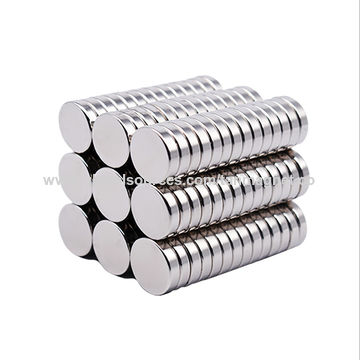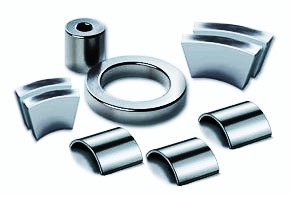Ndfeb
The neodymium magnet, also known as the NdFeB magnet, is a kind of artificial permanent magnet, also the most powerful permanent magnet to date. NdFeB magnets can attract objects up to 640 times their own weight. If divided by shape, the NdFeB magnets can be divided into round magnets, ring magnets, rectangular magnets, square magnets, and irregular magnets, etc. If divided according to their production process, NdFeB magnets can be divided into bonded NdFeB magnets and sintered NdFeB magnets. Bonded NdFeB magnets vs sintered NdFeBmagnets, what’s the difference between them? In this article, we will try to find the differences between bonded NdFeB magnets and sintered NdFeB magnets.
- A neodymium magnets (also known as NdFeB, NIB or Neo magnet), the most widely used type of rare-earth magnet, is a permanent magnet made from an alloy of neodymium, iron and boron to form the Nd2Fe14B tetragonal crystalline structure.
- The influence of magnetoelastic effects on the anisotropy in NdFeB permanent magnets has been investigated. A relation between the magnetostriction coefficients and the magnetoelastic anisotropy is derived for crystals with tetragonal symmetry.
- Neodymium Iron Boron magnets are a type of rare earth alloy that typically has two atoms of Neodymium (Nd), 14 atoms of Iron (Fe), and one atom of Boron (B) as its primary elements, hence their chemical composition Nd 2 Fe 14 B, which is commonly abbreviated as NdFeB.
NdFeB, in simple terms, is a magnet, which is different from the magnets we usually see. It is called 'king of magnetism' because of its excellent magnetic properties. Nd-Fe-B contains a large number of rare earth elements, neodymium, and iron and boron, which are characterized by hard and brittle properties.As the surface is easily oxidized. NdFeB are 1.05. This illustration shows a plot of a Load Line and its intersection with the Normal Curve. That intersection is known as the Operating Point.
Bonded NdFeB Magnets
Bonded NdFeB magnet, composed of Nd2Fe14B, is a synthetic magnet. Bonded NdFeB magnets are magnets made of rapidly quenched NdFeB magnetic powder and binder by “compression molding” or “injection molding”.
Bonded NdFeB magnets have high dimensional accuracy, can be made into magnetic components with relatively complex shapes, and have the characteristics of one-time molding and multi-polar orientation. The bonded NdFeB magnets have high mechanical strength and can be formed at one time with other supporting components during forming.
Thanks to their low cost, high dimensional accuracy, the large degree of freedom in shape, good mechanical strength, and light specific gravity, bonded NdFeB magnets are widely used in office automation equipment, Denso machinery, audiovisual equipment, instrumentation, small motors and metering machinery, mobile phones, CD-ROM, DVD-ROM drive motors, hard disk spindle motors HDD, other micro special DC motors and automated instruments and other fields. Their annual growth rate has reached 35%.
Compared with sintered NdFeB magnets, bonded NdFeB magnets can be formed at one time without secondary processing, and can be made into various shapes of complex magnets, which is also incomparable to sintered magnets. With the help of the bonded NdFeB magnets, people can greatly reduce the size and weight of the motor.
Sintered NdFeB Magnets
The sintered NdFeB magnet is made by powder metallurgyprocess. First, the smelted alloy needs to be powdered and pressed into a compact in a magnetic field, and then the compact is sintered in inert gas or vacuum to achieve densification.
In general, only the magnet blank can be produced after sintering, and then it can be turned into magnets of various shapes through mechanical processing (such as wire cutting, slicing, grinding, etc.).
Sintered NdFeB permanent magnets are widely used in electronics, electrical machinery, medical equipment, toys, packaging, hardware machinery, aerospace, and other fields. The more common ones are permanent magnet motors, speakers, magnetic separators, computer disk drives, and magnetic resonance imaging equipment instruments.
Compared with bonded NdFeB magnets, sintered NdFeB magnets have high processing costs, large loss during processing, and poor dimensional accuracy. But its advantage is also obvious. At present, the (BH) max of sintered NdFeB magnet can reach more than 50M, while the bonded magnet is generally below 10M.
Conclusion

Thank you for reading our article and we hope it can help you to have a better understanding of the differences between bonded NdFeB magnets and sintered NdFeB magnets. If you want to know more about neodymium magnets, we would like to advise you to visit Stanford Magnets for more information.
Stanford Magnets is a top magnet supplier across the world, who has been involved in R&D, manufacturing, and sales of magnets since the 1990s. It provides customers with high-quality rare earth permanent magnetic products such as neodymiummagnets, and other non-rare earth permanent magnets at a very competitive price.


Neodymium Magnet Rings
NdFeB Products Overview

Adams Magnetic, a leading supplier of neodymium magnets, neodymium (NdFeB) magnet discs, rings and blocks, offers a wide range of permanent magnet solutions for a wide range of industries.
What is a Neodymium Magnet?
A Neodymium magnet, also known as NdFeB or Neo magnet, is the strongest known type of permanent magnet. Because of their lightweight, strength and the consistency of their magnetization, Neodymium Magnets have become a popular choice for a wide variety of applications, from loudspeakers to magnetic therapy jewelry. A rare earth magnet is made from an alloy of neodymium, iron, and boron.
Machining & Magnetization
Adams designs and manufactures its own magnetizing fixtures either for use in house by customers as required.
Unlike other types of magnets, Neodymium magnets have a high resistance to demagnetization. They cannot be formed with conventional drilling, turning or milling processes, and must be ground before they are magnetized. Additionally, large or complex assemblies are usually magnetized prior to assembly. Standard tolerances for Neo magnetsare +/-.005 for ground dimensions. They require extremely high magnetizing fields and particular consideration must be given to this when designing complex assemblies. A Neodymium magnetcan be magnetized in any direction as long as it is aligned properly. In some instances multiple pole magnetization is not possible; when it is possible, special fixtures are required.
Ndfeb Grade N52
Temperature Considerations with Neodymium Magnets
A low coercivity grade Neodymium magnet may begin to lose strength if heated above 176°F (80°C). High coercivity grade Neodymium Magnetshave been developed to function at temperatures up to 428°F (220°C) with little irreversible loss. The need for low temperature coefficient in neodymium magnetapplications has triggered several grades to be developed to meet specific operating requirements. Please refer to our chart of magnetic properties to compare the characteristics of each grade.
Ndfeb Magnets
Demagnetization Curves
A second quadrant demagnetization curve provides information about the magnetic characteristics of a magnet, including the magnetic field strength and how resistant it is to demagnetize. How it is used in a magnetic circuit will affect its performance. When a permanent magnet is fully magnetized, its magnetic domains are aligned. Certain conditions such as temperature and reverse magnetic fields can cause some of the domains to lose this alignment and reverse, triggering the magnet to lose some or all of its magnetic field. You can view our material curves here.
Neodymium
Neodymium Magnet Applications
Ndfeb Permeability
Neodymium magnets have replaced Alnico and ferrite magnets in many applications where strong permanent magnets are required, because their greater strength allows the use of smaller, lighter magnets. These applications include:
Ndfeb Powder
- head actuators for computer hard disks
- magnetic resonance imaging (MRI)
- loudspeakers and headphones
- magnetic bearings and couplings
- cordless tools
- servo motors
- lifting and compressor motors
- synchronous motors
- spindle and stepper motors
- electrical power steering
- drive motors for hybrid and electric vehicles
- actuators

